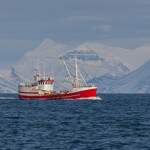Global Fishing Watch reveals world’s transshipping hotspots
Fishing vessel location data collected by satellites and run through advanced algorithms have drawn back the curtain on transshipping, a common method of mixing illegally caught fish with legal fish to slip it into global markets.
Global Fishing Watch, a partnership between Google and the advocacy groups Oceana and SkyTruth, released the results of the first global transshipping analysis at The Economist’s World Ocean Summit in Bali, Indonesia on 22 February. The report pinpointed the probable locations and frequency of transshipping.
“This activity that used to be completely obscure is now not,” David Kroodsma, the research program director at Global Fishing Watch, told SeafoodSource. “The oceans were this place that had been over the horizon and out of sight. And now they’re not.”
Fishing vessels can lengthen their time at sea and save on fuel costs by meeting other vessels to transfer seafood, fuel and supplies. During such transshipments, illegally caught fish can be mixed with legal fish, and brought to market. Advocates say the mixing and illicit transfers disguise catch levels, break the fish supply chain, and disrupt tracking and enforcement — causing difficulties for fishery managers seeking to rebuild depleted and overfished stocks.
“In order to sustainably manage our fisheries, we have to know what we’re taking out,” Beth Lowell, a senior campaign director at Oceana, told SeafoodSource. “It’s difficult to manage our oceans when you don’t know what’s being caught or being landed.”
Oceana wants transshipping banned, and thinks all fishing vessels should be required to transmit their locations using tracking devices, with data publicly available. The group wants every global fishing vessel to carry a unique identification number that is tied to the vessel regardless of its name or the flag it’s flying. Oceana is also seeking internationally consistent standards for catch documentation.
The new report shows that Russian waters were a hotspot for transshipping, accounting for half of all transshipments recorded by Global Fishing Watch. Russia also had the highest number of suspected transshipping meetings per vessel. Usually, Russian vessels were meeting other Russian vessels within Russian waters.
However, that was not the norm.Overall, 40 percent of transshipping took place on the high seas, often just outside national waters. Vessels hailed from various countries, frequently flying flags of convenience. Two other hotspots were in the waters just outside the exclusive economic zones of Argentina and Peru, while a third hotspot was in the national waters of Guinea-Bissau.
Only in the past few years have satellites enabled the large-scale collection of Automatic Identification Signals (AIS) from ships at sea. Global Fishing Watch purchased the commercial datasets, which can contain more than 20 million messages per day.
Transmitted over radio waves and broadcast as often as every two seconds, the AIS signals were originally designed to help vessels avoid collisions.By analyzing the convoluted strings of data, Global Fishing Watch was able to identify and track nearly 800, or 90 percent, of the world’s large refrigerated cargo vessels, or “reefers” — ships that collect the catch of multiple fishing boats and take it to ports. The group then mapped 5,065 instances of reefer vessels and fishing vessels moving at approximately the same speed in the same place at the same time — instances of likely transshipments.
Analyzing vessel movement patterns – using both human and computer analysis – allowed Global Fishing Watch to even identify different types of fishing boats and when they were actually fishing.
For instance, “a long-liner moves differently than a purse seiner, and your eye can tell,” said Kroodsma. “A purse seiner circles a school of fish with a net, while a long-liner goes in these long lines back and forth setting hooks.”The group found another 86,490 instances when one vessel’s behavior matched transshipment patterns, but appeared to be alone. Since only large vessels are legally required to have AIS devices, and many turn off their signals to go undetected, those instances also might have been transshipments.
Global Fishing Watch found at least two instances of fishing vessels staying at sea for more than 500 days in 2015 and 2016.
In one case, a South Korean vessel departed the Port of Busan and made a beeline for the equatorial Pacific, where it lingered. Part way through its journey, it likely met up with another vessel. After 525 days, it returned to Busan.
Meanwhile, a Chinese vessel left the Port of Singapore, cut swiftly across the Indian Ocean, rounded the southern tip of Africa, sailed north to the equatorial Atlantic and circled and crisscrossed a stretch of ocean between West Africa and Brazil. Out there, it likely rendezvoused with other vessels three times. More than 500 days later, it returned to port in Cape Town.





Share